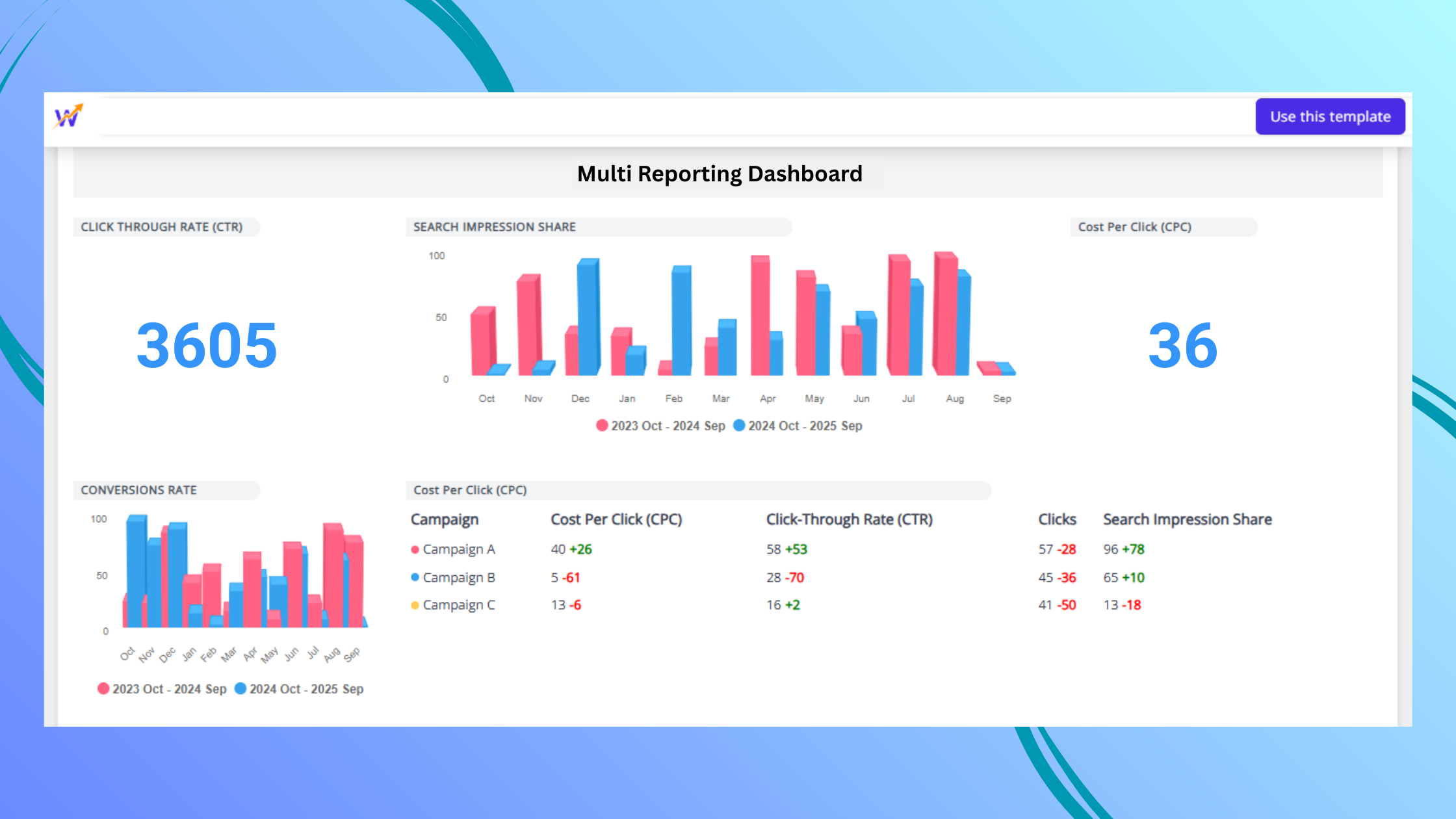In today’s competitive digital marketing landscape, agencies manage multiple clients, channels, and campaigns simultaneously. With so much data scattered across SEO platforms, social media accounts, PPC tools, and analytics software, reporting can quickly become overwhelming. This is where multi-dashboard reporting steps in as a game-changer.
What is Multi-Dashboard Reporting?
Multi-dashboard reporting allows agencies to create and manage multiple dashboards within one platform—each tailored to specific clients, campaigns, or KPIs. Instead of manually compiling spreadsheets or switching between tools, agencies can centralize all performance metrics into one unified system.
Why Agencies Need Multi-Dashboard Reporting
1. Client Transparency & Trust
Clients expect clear visibility into their marketing investments. Multi-dashboards give agencies the ability to:
- Provide client-specific dashboards with relevant KPIs.
- Offer real-time insights instead of static monthly reports.
- Build trust through transparency and accountability.
2. Time Savings & Efficiency
Without automated dashboards, reporting can consume hours of manual work:
- Collecting data from multiple sources.
- Formatting spreadsheets and presentations.
- Customizing reports for each client.
Multi-dashboard reporting automates this entire process, allowing teams to focus on strategy instead of spreadsheets.
3. Customization for Different Needs
Every client is unique. Multi-dashboard platforms let agencies:
- Personalize dashboards by industry, goals, or campaign type.
- Highlight metrics that matter most—whether it’s SEO rankings, social engagement, or PPC ROI.
- Brand dashboards with the agency’s or client’s logo for a professional touch.
4. Centralized Data for Better Decision-Making
Marketing teams often struggle with data silos. Multi-dashboards help by:
- Consolidating data from SEO, SEM, PPC, social media, and analytics tools.
- Reducing errors from manual entry.
- Enabling data-driven decision-making at scale.
5. Scalability for Growing Agencies
As agencies onboard more clients, the reporting workload grows exponentially. Multi-dashboard reporting ensures:
- Easy duplication of templates across clients.
- Quick setup for new accounts.
- Scalable reporting without adding headcount.
Whatsdash’s Latest Update: Multi-Dashboard Reporting at Its Best
However, let’s see the latest update of Whatsdash.This software has always been a robust analytics and reporting tool—but the latest enhancements take it to the next level. Here’s what stands out:
1. SEO reporting dashboard
The updated Whatsdash SEO reporting dashboard gives clients a clear, real-time view of their SEO performance in one place. It automatically pulls data from key sources like Google Analytics, Google Search Console, and keyword tracking tools, then presents it in an easy-to-read, branded dashboard.
Clients can instantly see:
- Keyword rankings and traffic trends
- Backlink growth and domain authority
- Click-through rates, impressions, and conversions
- Overall SEO health with visual charts and KPIs
No more manual reports or spreadsheets—clients log in anytime to track progress, compare results over time, and measure ROI with full transparency.
2. PPC reporting dashboard
The updated Whatsdash PPC reporting dashboard gives clients a real-time, centralized view of their ad performance across Google Ads, Facebook Ads, LinkedIn, and more. It automatically pulls data from multiple platforms, organizes it into a visual, easy-to-read dashboard, and highlights key metrics like CTR, conversions, CPC, and ROI.
Clients no longer need to sift through separate reports—Whatsdash delivers a customized, branded dashboard where they can track performance, compare campaigns, and measure ROI at a glance. This ensures full transparency, faster insights, and smarter decision-making.
3. Google analytics dashboard
The updated Google Analytics dashboard in Whatsdash simplifies complex data into an easy-to-read, real-time view for clients. It automatically pulls key metrics—like website traffic, user behavior, top pages, conversions, and acquisition channels—directly from Google Analytics. Clients can:
- Track performance in real time without logging into multiple tools.
- See tailored KPIs relevant to their business goals.
- Get visual insights through clean graphs and charts instead of raw numbers.
- Access reports anytime via a centralized, client-ready dashboard.
In short, the update turns raw Google Analytics data into actionable insights and transparent reporting, helping agencies prove value while saving time.
4. SMM reporting dashboard
The new SMM reporting dashboard in Whatsdash helps clients track all their social media performance in one place. It automatically pulls data from platforms like Facebook, Instagram, LinkedIn, and X (Twitter), and presents it in easy-to-read dashboards. Clients can:
- Monitor key metrics like engagement, reach, clicks, and follower growth.
- Compare campaign performance across different social channels.
- View real-time updates without waiting for monthly reports.
- Download or share branded reports instantly.
This means clients get clear insights, faster decisions, and proof of ROI—all without digging through multiple tools.
5. Ecommerce reporting dashboard
The new Ecommerce reporting dashboard in Whatsdash gives clients a single, real-time view of their online store performance. It automatically pulls data from platforms like Shopify, WooCommerce, Google Analytics, and ad channels, then organizes it into clear, customizable dashboards.
Clients can instantly track:
- Sales & Revenue trends
- Top-performing products & categories
- Customer behavior and conversion funnels
- Ad spend vs ROI across channels
With automated updates and pre-built templates, clients no longer need to dig through multiple tools. Instead, they get actionable insights at a glance to optimize campaigns, boost sales, and grow their ecommerce business.
Final Thoughts
Agencies craving productivity, clarity, and professionalism in reporting will find Whatsdash’s multi-dashboard capabilities transformative. With powerful data integrations, customizable dashboards, seamless automation, and collaborative features, it’s a game-changer—and the latest update cements its place as an essential tool for scaling.
Ready to elevate your reporting? Check out the dashboard demo or start your free trial to experience multi-dashboard magic firsthand.

